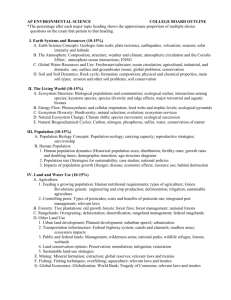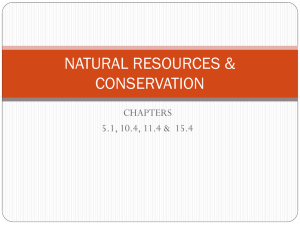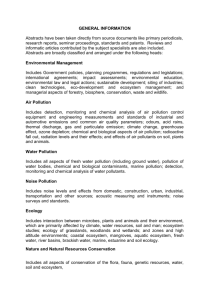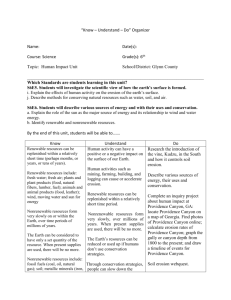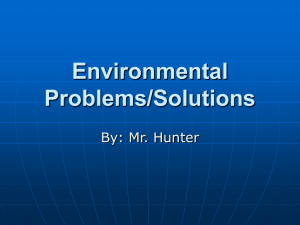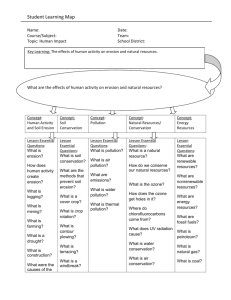Notes Ch.6 People and their Environment
advertisement
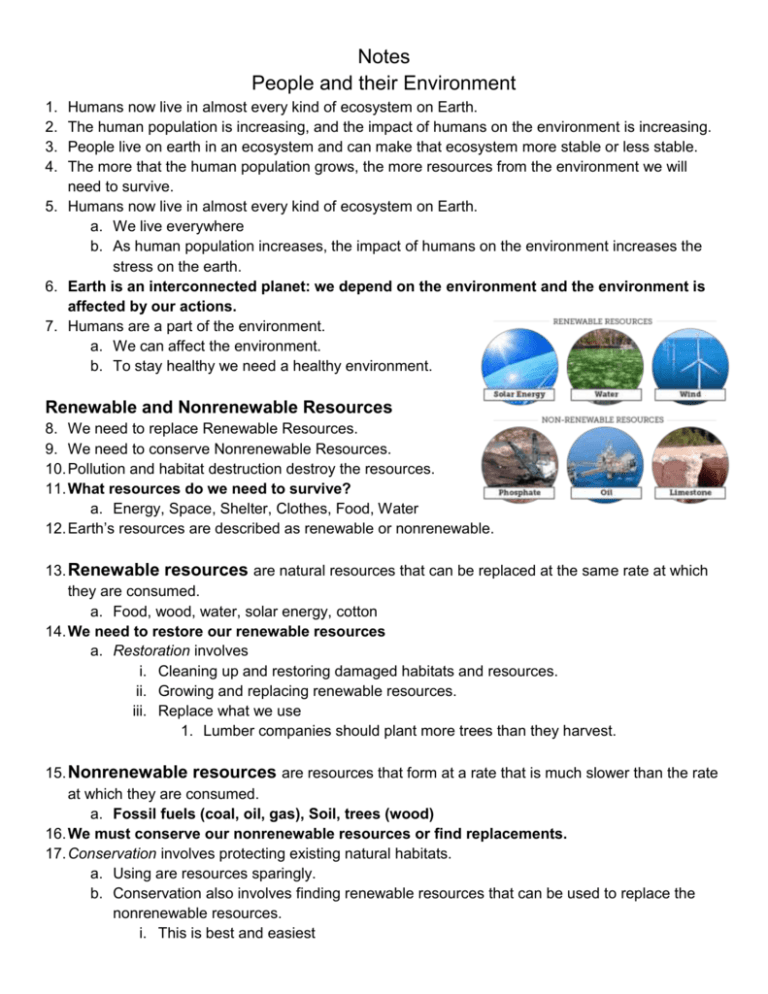
Notes People and their Environment 1. 2. 3. 4. Humans now live in almost every kind of ecosystem on Earth. The human population is increasing, and the impact of humans on the environment is increasing. People live on earth in an ecosystem and can make that ecosystem more stable or less stable. The more that the human population grows, the more resources from the environment we will need to survive. 5. Humans now live in almost every kind of ecosystem on Earth. a. We live everywhere b. As human population increases, the impact of humans on the environment increases the stress on the earth. 6. Earth is an interconnected planet: we depend on the environment and the environment is affected by our actions. 7. Humans are a part of the environment. a. We can affect the environment. b. To stay healthy we need a healthy environment. Renewable and Nonrenewable Resources 8. We need to replace Renewable Resources. 9. We need to conserve Nonrenewable Resources. 10. Pollution and habitat destruction destroy the resources. 11. What resources do we need to survive? a. Energy, Space, Shelter, Clothes, Food, Water 12. Earth’s resources are described as renewable or nonrenewable. 13. Renewable resources are natural resources that can be replaced at the same rate at which they are consumed. a. Food, wood, water, solar energy, cotton 14. We need to restore our renewable resources a. Restoration involves i. Cleaning up and restoring damaged habitats and resources. ii. Growing and replacing renewable resources. iii. Replace what we use 1. Lumber companies should plant more trees than they harvest. 15. Nonrenewable resources are resources that form at a rate that is much slower than the rate at which they are consumed. a. Fossil fuels (coal, oil, gas), Soil, trees (wood) 16. We must conserve our nonrenewable resources or find replacements. 17. Conservation involves protecting existing natural habitats. a. Using are resources sparingly. b. Conservation also involves finding renewable resources that can be used to replace the nonrenewable resources. i. This is best and easiest 18. Most important: Save our soil! a. Use compost piles b. Don’t let your soil wash or blow away Pollution and Habitat Destruction 19. Pollution and habitat destruction destroy the resources we need to live, such as; the air we breathe the water we drink, and the food we eat. 20. Air pollution causes respiratory problems for people, results in acid rain, damages the ozone layer, and may affect global temperature. a. Weather inversions trap the cold air in the valley b. All the pollution from cars, wood burning stoves and factories is also trapped making for very bad air. c. Acid rain is precipitation that has an unusually high concentration of sulfuric or nitric acids, which is caused by pollution. i. Acid rain damages forests and lakes. d. Ozone is being hurt from air pollution i. The ozone layer protects life on Earth from the sun’s damaging ultraviolet (UV) rays. ii. The ozone layer has been damaged by chlorofluorocarbons (CFCs). iii. CFCs are human-made chemicals that are used as coolants in refrigerators and air conditioners and as propellants in spray cans. iv. Without the ozone layer v. We all get cancer e. Global temperature may be affected by air pollutants. Global warming is the gradual increase in the average global temperature. i. The greenhouse effect is the warming of the surface and lower atmosphere of Earth that happens when greenhouse gases in the air absorb and reradiate heat. Examples of greenhouse gases are CO2 and water vapor H2O. ii. The greenhouse effect is a good thing. It is necessary to keep Earth’s temperatures warm and stable. iii. However, Earth’s global temperatures have been rising steadily for many decades. iv. Many scientists think that this increase in temperatures is caused by an increase in CO2 and other green house gasses. v. Burning fossil fuels increases the amount of CO2 in the atmosphere. Increases in atmospheric CO2 may be responsible for an increase in global temperatures. vi. Possible damage from global warming includes 1. melting ice sheets, 2. sea level rise, 3. destruction of coastal ecosystems, and 4. changes in ocean currents and 5. Changes in weather patterns. f. Water pollution can come from i. Fertilizers, pesticides, livestock, industrial waste, Oil, Antifreeze, septic tanks, unlined landfills. ii. Pollution can enters groundwater when polluted surface water percolates down through the soil. iii. Landfills and leaking underground septic tanks are also major sources of groundwater pollution. iv. When pollutants run off land and into rivers, both aquatic habitats and public water sources may be contaminated. v. Industrial waste are sometimes dumped directly into our water system. vi. People also dump waste directly into are water system vii. Sometimes sewage is added to our water system on purpose. Sometimes it happens accidentally. viii. Most cities have some type of sewage treatment plant. That cleans and breaks down the sewage waste. Importance of Soil 21. Fertile soil allows agriculture to supply the world with food. a. Food is one of our favorite things b. Without food we die c. Without good soil – we don’t get food and we die! d. Nutrients that make soil fertile come from the weathered rock as well as from bacteria, fungi and the remains of plants and animals. e. The processes that form just a few centimeters of fertile soil can take thousands of years. i. It take 100 years to grow 3 cm (1 inch) of soil f. The greatest threat to soil is soil erosion. g. Fires, construction, poor farming methods expose soil which leads to erosion. Habitat destruction 22. Ecosystem disruptions can result in loss of biodiversity, food supplies, potential cures for diseases, and the balance of ecosystems that supports all life on Earth. a. Over the last 50 years, about half of the world’s tropical rain forests have been cut down or burned for timber, pastureland, or farmland. This process of clearing forests is called deforestation. 23. Ecosystem Disruptions cause extinctions a. Ecosystem disruption decreases the number of Earth’s species. b. Biodiversity affects the stability of ecosystems and the sustainability of populations. Biodiversity is the variety of organisms in a given area. c. Wholly Mammoth and saber tooth tigers have become extinct. Probably due to global warming. Conservation and Restoration 24. Two major techniques for dealing with environmental problems are conservation and restoration. a. Conservation involves protecting existing natural habitats. i. This is best and easiest b. Restoration involves cleaning up and restoring damaged habitats. 25. We can reduce our use of resources, such as water and fossil fuels for energy. a. Recycling. We can reuse goods rather than disposing of them. i. Paper, cans, plastic, glass 26. Research and technology can help protect our environment by providing cleaner energy sources, better ways to deal with waste, and improved methods for cleaning up pollution. a. Alternative sources of energy i. Solar energy, wind energy Environmental Awareness 27. Educating the public about the environment helps gain public support for solving environmental issues. 28. Ecotourism is one way to educate the public about the environment. Ecotourism is a form of tourism that supports conservation of the environment. 29. If we plan the future will be so bright we’ll have to use shades.


